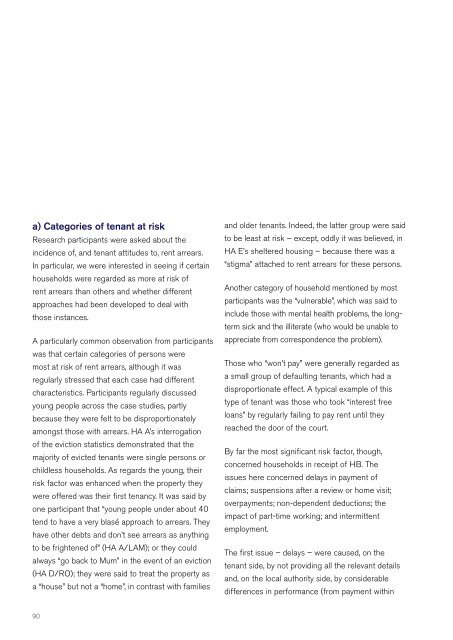Rent arrears management practices in the housing association sector
Rent arrears management practices in the housing association sector
Rent arrears management practices in the housing association sector
You also want an ePaper? Increase the reach of your titles
YUMPU automatically turns print PDFs into web optimized ePapers that Google loves.
a) Categories of tenant at risk<br />
Research participants were asked about <strong>the</strong><br />
<strong>in</strong>cidence of, and tenant attitudes to, rent <strong>arrears</strong> .<br />
In particular, we were <strong>in</strong>terested <strong>in</strong> see<strong>in</strong>g if certa<strong>in</strong><br />
households were regarded as more at risk of<br />
rent <strong>arrears</strong> than o<strong>the</strong>rs and whe<strong>the</strong>r different<br />
approaches had been developed to deal with<br />
those <strong>in</strong>stances .<br />
A particularly common observation from participants<br />
was that certa<strong>in</strong> categories of persons were<br />
most at risk of rent <strong>arrears</strong>, although it was<br />
regularly stressed that each case had different<br />
characteristics . Participants regularly discussed<br />
young people across <strong>the</strong> case studies, partly<br />
because <strong>the</strong>y were felt to be disproportionately<br />
amongst those with <strong>arrears</strong> . HA A’s <strong>in</strong>terrogation<br />
of <strong>the</strong> eviction statistics demonstrated that <strong>the</strong><br />
majority of evicted tenants were s<strong>in</strong>gle persons or<br />
childless households . As regards <strong>the</strong> young, <strong>the</strong>ir<br />
risk factor was enhanced when <strong>the</strong> property <strong>the</strong>y<br />
were offered was <strong>the</strong>ir first tenancy . It was said by<br />
one participant that “young people under about 40<br />
tend to have a very blasé approach to <strong>arrears</strong> . They<br />
have o<strong>the</strong>r debts and don’t see <strong>arrears</strong> as anyth<strong>in</strong>g<br />
to be frightened of” (HA A/LAM); or <strong>the</strong>y could<br />
always “go back to Mum” <strong>in</strong> <strong>the</strong> event of an eviction<br />
(HA D/RO); <strong>the</strong>y were said to treat <strong>the</strong> property as<br />
a “house” but not a “home”, <strong>in</strong> contrast with families<br />
90<br />
and older tenants . Indeed, <strong>the</strong> latter group were said<br />
to be least at risk – except, oddly it was believed, <strong>in</strong><br />
HA E’s sheltered hous<strong>in</strong>g – because <strong>the</strong>re was a<br />
“stigma” attached to rent <strong>arrears</strong> for <strong>the</strong>se persons .<br />
Ano<strong>the</strong>r category of household mentioned by most<br />
participants was <strong>the</strong> “vulnerable”, which was said to<br />
<strong>in</strong>clude those with mental health problems, <strong>the</strong> longterm<br />
sick and <strong>the</strong> illiterate (who would be unable to<br />
appreciate from correspondence <strong>the</strong> problem) .<br />
Those who “won’t pay” were generally regarded as<br />
a small group of default<strong>in</strong>g tenants, which had a<br />
disproportionate effect . A typical example of this<br />
type of tenant was those who took “<strong>in</strong>terest free<br />
loans” by regularly fail<strong>in</strong>g to pay rent until <strong>the</strong>y<br />
reached <strong>the</strong> door of <strong>the</strong> court .<br />
By far <strong>the</strong> most significant risk factor, though,<br />
concerned households <strong>in</strong> receipt of HB . The<br />
issues here concerned delays <strong>in</strong> payment of<br />
claims; suspensions after a review or home visit;<br />
overpayments; non-dependent deductions; <strong>the</strong><br />
impact of part-time work<strong>in</strong>g; and <strong>in</strong>termittent<br />
employment .<br />
The first issue – delays – were caused, on <strong>the</strong><br />
tenant side, by not provid<strong>in</strong>g all <strong>the</strong> relevant details<br />
and, on <strong>the</strong> local authority side, by considerable<br />
differences <strong>in</strong> performance (from payment with<strong>in</strong>




